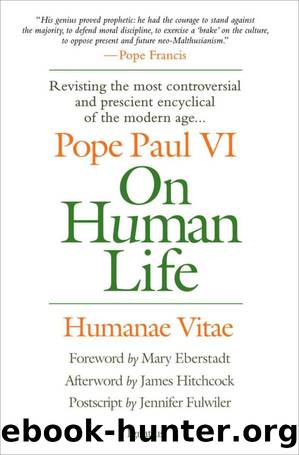On Human Life: Humanae Vitae by Pope Paul VI

Author:Pope Paul VI [VI, Pope Paul]
Language: eng
Format: epub
Tags: Spiritual & Religion
Publisher: Ignatius Press
Published: 2014-11-04T16:00:00+00:00
A HISTORICAL AFTERWORD
by James Hitchcock
From earliest times the Catholic Church condemned the use of contraceptives, and the Protestant churches retained that prohibition until the 1930 Lambeth Conference of the Anglican Church, which cautiously allowed it. Perhaps partly in response, the next year Pope Pius XI issued the encyclical Casti Connubii (âChaste Marriageâ), reaffirming the traditional Christian teaching. But in the following decades virtually all Protestant denominations at least passively accepted artificial birth control, primarily condoms and diaphragms.
The appearance of the first oral contraceptives (âThe Pillâ) in the early 1960s raised expectations that the Catholic Church might reconsider its position. The Second Vatican Council (1962â1965) spoke of the union of the spouses, as one of the purposes of marriage, along with procreation, and this led some people to think that marital union might justify contraception.
At the time much was made of the claim that one of the principal developers of The Pill, Dr. John Rock of Harvard University, was a devout Catholic, as though that in itself might justify use of his invention.
In 1963 Pope John XXIII (1958â1963) established a commission to study questions of birth control and population. Later Pope Paul VI (1963â1978) removed the subject from the floor of the Council and enlarged the commission to fifty-eight members, including married couples. Its authority was consultative only.
The commission held its final meeting in 1966 and made a report to the popeâapproved by a majority of its membersâadvising that the Church should approve at least some forms of contraception for married couples. A minority opposed the report and submitted its own.
Although Paul VI himself reaffirmed the traditional teaching several times in the period 1965â1968, the fact that the question was under study by a commission naturally led to speculation that it would be changed, especially because of the popular impression that the primary purpose of Vatican II was to release Catholics from âoutdatedâ rules and dogmas.
During this crucial period of uncertainty a few Europeansânotably Bishop Wilhelmis Bekkers of the Netherlands and the theologian Louis Janssen of Belgiumâopenly suggested that the doctrine could and should change. In the United States during that period virtually every significant Catholic journal eventually came to the same conclusion.
As it began to seem likely that the pope would authoritatively pronounce on the subject, some members of the papal commission attempted to force the issue by leaking the majority report to the media. It achieved wide notice and once again seemed to imply that change was inevitable.
Humanae Vitae was issued on July 25, 1968. The year was crucial in terms of the negative reaction to the encyclical, because it was the peak year of a world-wide rebellion against authority that had been building up for half a decade and that manifested itself in politics, education, religion, and many other things. The rejection of all sexual restraints was at the heart of this âcounter cultureâ, and Humanae Vitae was a direct challenge to that rebellion.
While the culture at large greeted the encyclical with extreme hostility, there was often virulent
Download
This site does not store any files on its server. We only index and link to content provided by other sites. Please contact the content providers to delete copyright contents if any and email us, we'll remove relevant links or contents immediately.
The Lost Art of Listening by Michael P. Nichols(6462)
Why I Am Not A Calvinist by Dr. Peter S. Ruckman(3767)
The Rosicrucians by Christopher McIntosh(3046)
Wicca: a guide for the solitary practitioner by Scott Cunningham(2702)
Signature in the Cell: DNA and the Evidence for Intelligent Design by Stephen C. Meyer(2495)
Real Sex by Lauren F. Winner(2466)
The Holy Spirit by Billy Graham(2408)
To Light a Sacred Flame by Silver RavenWolf(2350)
The End of Faith by Sam Harris(2279)
The Gnostic Gospels by Pagels Elaine(2023)
Nine Parts of Desire by Geraldine Brooks(2002)
Waking Up by Sam Harris(1953)
Heavens on Earth by Michael Shermer(1950)
Devil, The by Almond Philip C(1896)
Jesus by Paul Johnson(1882)
The God delusion by Richard Dawkins(1843)
Kundalini by Gopi Krishna(1821)
Chosen by God by R. C. Sproul(1754)
The Nature of Consciousness by Rupert Spira(1687)
